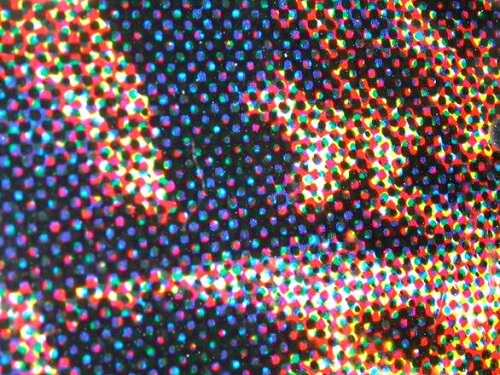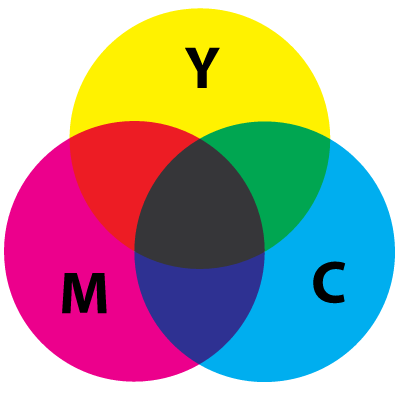How Does Four Color Process Printing Work?

Efficient, cheap, and versatile printing methods have been pursued since printing technology was first established. Along the way, many improvements have been made, and dozens of printing methods have been established. Whether they’re used for art, science, or business, the wheel of progress moves on in the field of printing, producing methods of astounding worldwide success.
While many of these changes have led to increasingly efficient technology, color advancements have made printing images and photos easier. Read on to learn more about the advancement of color in printing and how four color process printing works.
RGB Color
Most screens function with RGB color, where the amount of Red, Green, and Blue are represented by respective values ranging from 0 to 255. For example, 0 for all three colors will give you black, while 255 will culminate in white. Try 255 for red and green but 0 for blue to get yellow, and 255 for red and blue to get purple.
Every conceivable color can be displayed through your monitor, pixel by pixel, using this process. Nowadays, programs and online utilities are used to easily convert RGB into over color schemes such as CMYK, which is used for printing.
Printing in Color
For printing, the RGB method of color representation can’t be used because it requires light to be emitted from the source of each color, like a backlit screen. If you’re printing onto a static, matte medium like paper, it’s more than likely you’re going to use a four color printing process.
The four color printing process is a method of creating full-color images without having to use inks of every shade and hue. A color model called CMYK printing is one of the most popular, and it uses only four colors to create the others. CMYK stands for the four colors used during printing: Cyan, Magenta, Yellow, and Key (another term for black). When these four colors are layered on top of one other—dot by dot and with varying density—they can recreate any color image with precise detail.
Who Uses the Four Color Process Printing?
CMYK printing is a much more popular choice for printed publications of all sorts due to its simplicity. Using the Pantone color system necessitates using a complex list of neverending colors and their corresponding complements. Pantone printing is generally reserved for designers and artists, while CMYK is used in most newspapers, magazines, advertising brochures, billboards, and even homes or businesses. While many will gladly forego color printing for the more day-to-day affordability of grayscale printing, CMYK methods of printing are near ubiquitous in most fields.
Advantages of CMYK
There are other printing method besides four color process printing, each with their distinct strengths and weaknesses when compared to CMYK. Two of the most popular methods, PMS and Spot Printing, are also frequently used by professionals.
In a consumer printer, CMYK printing is accomplished via a set of four distinct cartridges plugged into the cartridge slot of the printer or scanner. Each cartridge represents a different color in the CMYK acronym, and when one is depleted, it can be swapped out without having to purchase an all-purpose color cartridge, making it a cost-effective choice in the long run. This compartmentalized replacement is another reason why many consumers are switching to this printing method.
PMS, or the Pantone Matching System, is a proprietary color scheme, in which each color is represented with a unique value and is not a mixture of several concurrent colors. The Pantone system allows for more exact color schemes, devoid of blurring. The downside is that it requires heavier, more expensive ink that is often not compatible with all types of paper.
Spot Printing produces pre-mixed colors, instead of combining different levels of Cyan, Magenta, Yellow, and Black. The spectrum of colors available for Spot Printing is far more limited (usually between one and three colors per page), but the tradeoff is significant. CMYK printing combines its colors slightly differently for every page printed. Spot printing, on the other hand, always produces the same colors in the same way, since mixing is performed before the printing process has begun.
How Images are Printed in Four Color Process Printing

CMYK printing is a subtractive printing process, rather than an additive one, because it subtracts brightness from its printing surface. The ink from this printing method covers up lighter colors, like the white of the paper that the ink is being applied to. The most common process used to print in CMYK is often referred to as Offset Lithography, and is accomplished through a technically complicated, yet efficient method.
Offset Lithography follows the following techniques:
- Rollers apply water on a lithograph plate in the area where there is to be no ink.
- The rest of the area is filled in with an oil-based ink, which repels from the water and adheres only to specific areas.
- Ink is added from the four colors using four rollers.
- The ink is exposed to air and sometimes even heating rolled to dry.
The first color to be added is Cyan, then Magenta, then Yellow, and then Black. This may seem obvious given the acronym, but it’s worth stressing that the black colors in an image would be muddled or invisible if black was applied first.
An interesting example of this layering can be found in promotional posters from the 80s. As the ink ages and fades, each layer of ink is weathered away by exposure to the sun and the elements. First to fade is black, then yellow, then magenta, until finally the posters are permeated by a light blue. Since the cyan ink was applied first in the creation of these posters, it is the last one to fade away once the other colors are gone.
Four Over Four
Several numeric identifiers are used to understand the nature of a printed object after it has had CMYK ink applied to it. These ratios help as a shorthand identifier to ensure that the correct amount of ink is applied to either side of a piece during printing. Here are some of the most commonly used identifiers:
- Four over four (4/4) refers to the four colors (CMYK) on each side of the document, front and back.
- Four over one (4/1) refers to four colors on one side, and one color on the other.
- Four over zero (4/0) indicates a sheet that only has ink on one side. The other side is blank and featureless.
- One over zero (1/0) has only one color on the inked side and no color on the other side.
- One over one (1/1) indicates that both sides are inked with a single color.
There are infrequently used terms, such as 2/1 or 2/2, which are specifically used to indicate certain aspects of a printed page when using Spot Printing.
Finding Affordable Ink
Some publications will use a combination of CMYK, PMS, and Spot Printing to produce a document that takes advantage of the strengths inherent to each method. No matter which method you’ve chosen, you can be sure that years of technological development has led to their convenient implementation.
If you’re ready to start using the four color printing process, or are already using it and looking to find an alternative, cost-efficient venue for buying ink, look no further than 1ink.com. We provide over a thousand varieties of remanufactured ink cartridges at half the OEM price, servicing over 500 printers.
Explore our wide selection of printing supplies for Canon, Xerox, and Epson, and learn more about printers and ink and toner cartridges on our blog.
